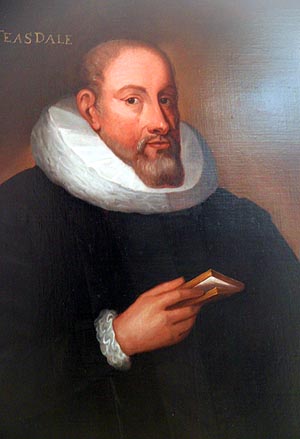 |
 |
|||
|
|
Thomas Tesdale, the primary co-founder of Pembroke College, Oxford, was the son of Thomas Tesdale Senior (d. 1556) by his second wife, Joan Knapp. His grandfather, John Tesdale, is described as 'of the north' and his two sons came south to Hanney and then Stanford Dingley in Berkshire. The elder, John, who took the name of Cliffe upon entering religion. Thomas Junior was born at Stanford Dingley and baptised there on 13th October 1547. When he was a child, his father moved the family to FitzHarris Farm at Abingdon, in which town he became a governor of Christ's Hospital, and was buried at St. Helen's Church in 1556. The father, in his will, charged Richard Tesdale, his brother, a sadler of Abingdon, and William Hopkyns of Abingdon, to bring up young Thomas in learning, and to apprentice him in London. His uncle sent him to school, firstly at the old Grammar School in Stert Street, and afterwards, when Tesdale was nearly sixteen, he was chosen and admitted by John Royse as the first scholar in his Free School in Abingdon. At the age of twenty, he married Maud, the daughter of Reynold Stone of Henley-on-Thames (Oxfordshire) and widow of Edward Little of Abingdon, who had been a maid of honour to Queen Elizabeth. Sadly, their three children all died in infancy. At Abingdon, Tesdale "traded in the making of malt, then a very gainful course there". He soon gained wealth and reputation and held many offices in the town. Tesdale was, like his father before him, a governor of Christ's Hospital in Abingdon, from 1577-81, and Master in 1579. In 1581, he filled the office of Mayor of Abingdon, but always afterwards refused it. Having greater ambitions than the municipal work of a small town, he removed himself from Abingdon to Ludwell Manor (Oxfordshire), about 1586. He, afterwards, settled in Glympton, near Woodstock, where "he traded in sowing and making of woad—used by dyers—, and was held to be the greatest dealer therein that was in the whole realm ; whereby, and by tillage for corn and by grazing of cattle, he attained to a great estate." He died there on 13th June 1610, aged 63. He was buried in Glympton Church, under a fine alabaster tomb, where was also laid his wife, Maud. He was an eager and successful man of business and, by his farming and malting and other forms of trading, acquired considerable wealth. Fuller relates that he was clothier to the royal army and at one time an attendant at court. By his will, dated 8th May 1610 (in addition to other benefactions to Abingdon), he bequeathed tithes and land at Upton in Warwickshire for the support of an Usher at Roysse's School. He also set aside a sum of £5,000 for the reception and training at one of the Oxford colleges of seven fellows and six scholars from Abingdon School. At first, Balliol College was selected, but the Society of Balliol, already hampered by their obligations to Tiverton School, seem to have tried hard to obtain a relaxation of the conditions attached to the bequest, but the negotiations were not completed in 1623 when Richard Wightwick BD, Rector of East Ilsley and formerly of Balliol College, offered to augment Tesdale's foundation. "It then fell under consideration," says Fuller, "that it was a pity so great a bounty (substantial enough to stand by itself) should be adjected to a former foundation." The feoffees under Tesdale's will, headed by Archbishop George Abbot, acquiesced in the project of a new college. The King was approached through the chancellor, William Herbert, 3rd Earl of Pembroke, and, James consenting, the existing foundation of Broadgates Hall "was erected by the name of Pembroke College" on 29th June 1624. Tesdale's coat of arms is—Argent, a chevron vert between three teazles proper. The teazles are a punning reference to his trade as clothier and to the pronunciation of his name. Partly edited from Leslie Stephens & Sidney Lee's "Dictionary of National Biography" (1891).
|
|||
| © Nash Ford Publishing 2004. All Rights Reserved. | ||||



 Thomas
Tesdale (1547-1610)
Thomas
Tesdale (1547-1610)